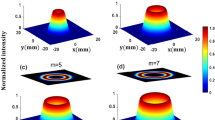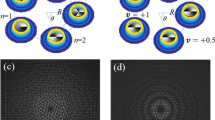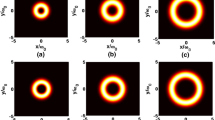Abstract
The auto-focusing and auto-healing profiles of linearly polarized ring Airy Gaussian vortex (RAiGV) beams in linear media are investigated experimentally based on spatial light modulators and computer-generated holograms. It is found that the parameters of incident beams greatly affect the auto-focusing profiles of RAiGV. The focal length increases as the radius of the primary ring, scaling factor and waist radius increases, and the focal length decreases slightly as topological charges increase. The peak intensity at focal point increases with the increasing topological charges and waist radius, or with the decreasing scaling factor and the radius of the primary ring. The phase singularity of the RAiGV beams remains unchanged during propagation. The RAiGV beams also exhibit remarkable resilience against perturbations and tend to reconstruct its intensity sharp. Meanwhile, the abruptly auto-focusing property can be controlled by blocking few inner or outer rings of the RAiGV beams. These studies provide useful insight in the study of Airy vortex beam and its further applications.
Similar content being viewed by others
Avoid common mistakes on your manuscript.
1 Introduction
The radially symmetric ring Airy Gaussian vortex (RAiGV) beams have attracted great attention due to its unique characteristics of self-focusing and self-healing [1, 2]. This beam abruptly focuses its energy right at the focal point while maintaining a low intensity profile before. Their maximum intensity increases abruptly by orders of magnitude just at the focus [3,4,5]. Self-healing indicates that the RAiGV beams can be reconstructed during propagation in spite of the severity of the imposed perturbations [6, 7]. These exotic properties have been applied in various applications, such as optical trapping, bio-medical treatment, optical clearing and light bullet generation [8,9,10]. Moreover, the RAiGV beams with its intensity distribution at focal spot being hollow or carried with orbital angular momentum can greatly enlarge its application, such as manipulating the particles whose refractive indices are lower than surrounding medium.
The research of the superposition of Airy beam and a vortex optical focuses on three aspects: one dimensional (1D) Airy vortex beams, two dimensional (2D) Airy vortex beams and ring Airy vortex (RAiV) beams [11,12,13]. On comparing with 1D and 2D Airy vortex beams, the RAiGV beams will be more suitable for optical tweezers because the symmetric light intensity distribution can greatly simplify the experimental configuration. In practice, there are two available ways to generate RAiGV beams, including Fourier transform method and off-axis interference patterns [14, 15]. The study of RAiV beams has received a considerable boost in the past few years. Deng et al. numerically presented the propagation properties of the sharply auto-focused RAiGV beams [3]. Li et al. theoretically investigated the propagation characteristics of RAiV beams [5]. Davis et al. experimentally showed the relationship between a cubic phase mask and the focusing properties of RAiV beams [16]. Zhang et al. numerically investigated the auto-focusing properties of circular Airy beams (CAB) [17]. Jiang et al. investigated the propagation dynamics of CAVB by numerical calculation [18]. It has come to our knowledge that experimental study on the propagation characteristics of the RAiGV beams has not been reported so far. In this paper, we experimentally study the propagation profiles of RAiGV beams including focal intensity, focal length as well as the trajectory of self-focusing. Meanwhile, we further investigate the phase singularity and self-healing behavior of RAiGV beams during propagation.
2 Equation modeling for RAiGV beams
The RAiGV beam is a solution of Maxwell’s equation that obeys axial symmetry in both amplitude and phase. Under paraxial approximation, the propagation of the field envelope \( \psi (x,y,z) \) is obtained by solving the equation [3].
where \( \nabla^{2} = (\partial^{2} /\partial x^{2} + \partial^{2} /\partial y^{2} ) \), x and y are the transverse coordinates, z is the propagation distance, \( k = 2\pi /\lambda \) is the wave number, \( \lambda \) is the wavelength. For paraxial solution in cylindrical coordinate r, \( \varphi \) and z, Eq. (1) can be expressed as:
and the axially symmetric solution of the electric field will have the form:
where l is the topological charge.
The electric field distribution of RAiGV beams at the input plane is a special solution of Eq. (2), which can be expressed as [1,2,3]:
where Ai(.) denotes the Airy function, r is the radius distance, r 0 is related with the initial radius of the RAiGV beams, a is the decay factor, w 0 is waist radius, b is scaling factor. The abruptly auto-focusing characteristic is originated from the Airy function.
Since it is very difficult to get the electric field \( \psi (r,\varphi ,z) \) of the propagation analytically, we use split step discrete fast Fourier transform method to solve Eq. (1) and get the electric field \( \psi (r,\varphi ,z) \) by taking Eq. (4) as the initial electric field in this paper [19, 20].
3 Experimental study on the propagation characteristics of RAiGV beams
3.1 Experimental setup
The schematic of the experimental setup is shown in Fig. 1. The light emitted from the source He–Ne laser is expanded by the beam expander (BE). Polarizer Pl is used to adjust the polarization direction of the incident beam. Then, the broad Gaussian laser beam illuminates the SLM (Holoeye Pluto, 1920 × 1080 pixels with pixel size of 8 μm) to generate linearly polarized RAiGV beams. The SLM is loaded with the computer-generated holograms based on the Airy function. The 4f system (L1 and L2) and spatial filter (SF) are used to obtain the first-order diffraction pattern of RAiGV beam. The intensity distributions are recorded by CCD camera at different distance. A neutral density filter (NDF) is placed in front of the CCD to avoid saturation of the CCD [21]. In this paper, we generate the CAVB with various parameters by uploading different holograms on the SLM.
3.2 Abruptly auto-focusing characteristics of RAiGV beams
To experimentally demonstrate such a self-focusing characteristic of RAiGV beams, we capture a series of intensity profiles at various distances before and after the focus point. In our experiments, the RAiGV beam with a = 0.05, b = 0.1, \( \lambda \) = 632.8 nm, w 0 = 0.6 mm, r 0 = 1 mm and l = 1 is generated. In Fig. 2, top panels and bottom panels present the transverse snapshots at z = {20, 26, 32, 38} cm from the simulation and experiment, respectively, where the observed distances z is defined as the distance between SLM and CCD. It is clearly seen that the RAiGV beams possess a donut-shaped transverse pattern in the main lobe surrounded by a series of rings at z = 20 cm, as shown in Fig. 2a. When the beam propagates along the z direction, the radius of beam becomes smaller, as shown in Fig. 2b. Then, at a longer propagation distance, the main lobe becomes even smaller and reaches its maximum intensity, as shown in Fig. 2c. The position of z = 32 cm is defined as the focal point since the beam focuses its most energy here. The experimental data show that the diameter of the focal point decreases to about 1/10 of z = 20 cm. After the focal spot, the beam begins to disperse and its distribution is similar to the Bessel function, as shown in Fig. 2d. We measure the radius of the first ring of RAiGV beams at different distance and map out the self-focusing trajectory, as shown in Fig. 3b. Note that when z increases, the radius of RAiGV beams shrinks in a parabolic trajectory. The beam is abruptly focused at a certain point about z = 32 cm. Figure 3a shows the numerical simulated side-view propagation of the RAiGV beams in free space. The experimental auto-focusing results are in good agreement with the numerical simulation.
The effects of topological charges l, scaling factor b, the radius of the primary ring r 0 and waist radius w 0 on the auto-focusing profiles for RAiGV beams also are studied. Experimental results are shown in Figs. 4, 5, 6 and 7. The intensity contrast I F/I 0 and focal length are used to describe the abruptly auto-focusing of the beam. I 0 is the maximum intensity of the initial plane and I F is the maximum intensity of arbitrary plane along the propagation direction.
The effect of the topological charges l on the auto-focusing profiles for RAiGV beams is shown in Fig. 4. Figure 4a, b compares the intensity of the initial of RAiGV beams with l = 1 and l = 3, which show that the number of Airy ring and radius of the beam increase with the increasing l. Figure 4c, d shows that the high-order RAiGV beams (l > 1) will become a decayed optical distribution with multiple one charge singularities along a line during propagation, which is caused by phase noise or asymmetrical intensity distribution of RAiGV beams. Figure 4e shows that I F/I 0 becomes larger and the focal length becomes tiny smaller when l increases. Figures 4a and 5a compare the initial intensity of incident RAiGV beams for b = 0.12 and b = 0.1, which show that the number of Airy ring decreases as b increases. I F/I 0 decreases and the focal depth increases with the increase of b, as shown in Fig. 5b, c. Figures 4a and 6a compare the initial intensity of incident RAiGV beams for r 0 = 1.2 mm and r 0 = 1 mm, which show that increasing r 0 makes the number of Airy ring increase. Figure 6b shows the peak intensity distribution for r 0 = 0.8, 1 and 1.2 mm, which indicates that I F/I 0 decreases with the increasing of r 0. Figure 6c shows that the focal depth increases with the increase of r 0. Figures 4a and 7a compare the initial intensity of incident RAiGV beams for w 0 = 0.8 mm and w 0 = 0.6 mm, which show that higher w 0 corresponds to the more number of Airy ring at initial plane. From Fig. 7b, c, it is observed that I F/I 0 and the focal depth increase with the increase of w 0. These experimental results are in good agreement with the theory simulation. The numerical and experimental analysis shows that the focal length and the intensity of the optical focus can be modified by adjusting the parameters of the RAiGV beams.
3.3 Phase singularity of the RAiGV beams
To check the phase structure of RAiGV beams, we measure the interference pattern between RAiGV beams with l = 1, 2 and the fundamental Gaussian beam. The interference patterns at propagation distance 27, 29, 31, 35 cm are shown in Fig. 8. In Fig. 8a1–a4, one line is divided into two lines at the center of each interference pattern, and in Fig. 8b1–b4, one line is divided into three lines at the center of each interference pattern, which indicates that the topological charges of RAiGV beams remain unchanged during the propagation.
3.4 Self-healing performance
To observe self-healing of RAiGV beams, an opaque disk with diameter of 2 mm is used to obstruct the beam at different transverse positions and monitor their reconstruction during propagation. Figure 9a1, c1 presents the intensity distributions of unblocked RAiGV beam at z = 5 cm and focal point z = 32 cm, respectively. An opaque disk is used to obstruct the first inner ring of RAiGV beam and the resulting intensity distribution is shown in Fig. 9a2–c2. The self-healing of the beam is apparent at z = 12 cm and the focal position at z = 32 cm. When the first few inner rings are blocked, the intensity distributions are shown in Fig. 9a3–c3. The beam recovers its initial sharp at about z = 16 cm and the focal length is 30 cm. We also observe that the focal length decreases when more inner rings are blocked. Then, a few outer rings of RAiGV beams are blocked and the intensity distributions are shown in Fig. 9a4–c4. Remarkably, the beam self-heals its initial sharp at about z = 10 cm and the focal length is shifted down to 28 cm. Finally, the RAiGV beams are blocked with a linear opaque object, as shown in Fig. 9a5–c5. In this case, the beam recovers its initial sharp at about z = 15 cm and the focal length is 32 cm. So far we experimentally demonstrate that the RAiGV beams can reconstruct itself when it is partially blocked.
Self-healing of RAiGV beams when it is obstructed at different transverse positions. The top panels are the intensity at z = 5 cm, the middle panels are the intensity at recover position, the bottom panels are the intensity at focal point. a1–c1 unblocked RAiGV beams; a2–c2 the first inner ring is blocked; a3–c3 the few inner rings are blocked; a4–c4 the few outer rings are blocked; a5–c5 blocked by a linear opaque object
4 Conclusion
The propagation properties of RAiGV beams are studied experimentally. It is found that the focal depth and focal intensity can be modified by appropriately selecting the parameters of RAiGV beams, such as topological charges, scaling factor, the radius of the primary ring and waist radius. In addition, interference pattern is used to observe the phase structure of RAiGV beams, which shows that the vortex characteristics remain unchanged during propagation. Finally, the self-healing profile of RAiGV beams is studied by blocking an opaque disk at different transverse positions. The results show that when the first few inner or outer rings of the RAiGV beams are blocked, the intensity distribution can be reconstructed during propagation and the focal depth becomes shorter. The experimental results are in good agreement with the numerical simulation. We believe that the investigation of RAiGV beams is helpful in its various applications, such as particle manipulation, optical communication and medical treatment.
References
N. Voloch-Bloch, Y. Lereah, Y. Lilach, A. Gover, A. Aire, Nature 494, 331 (2013)
P. Panagiotopoulos, D.G. Papazoglou, A. Couairon, S. Tzortzkis, Nat. Commun. 4, 1 (2013)
B. Chen, C.D. Chen, X. Peng, Y. Peng, M. Zhou, D. Deng, Opt. Express 23, 19288 (2015)
N. Wiersma, N. Marsal, M. Sciamanna, D. Wolfersberger, Sci. Rep. 5, 13463 (2015)
N. Li, Y. Jiang, K. Huang, X. Lu, Opt. Express 22, 22847 (2014)
B. Chen, C. Chen, X. Peng, J. Opt. 18, 055504 (2016)
J. Broky, G. Siviloglou, A. Dogariu, Opt. Express 16, 12880 (2008)
K. Cheng, G. Lu, X. Zhong, Appl. Phys. B 123, 60 (2017)
Z. Zhao, W. Zang, J. Tian, J. Opt. 18, 025607 (2016)
J. Wang, A. Cao, M. Zhang, IEEE Photonics J. 8, 1 (2016)
F. Wang, C. Zhao, Y. Dong, Appl. Phys. B 117, 905 (2014)
Y. Qian, D. Li, H. Mao, JOSA A 34, 314 (2017)
J. Zhou, Y. Liu, Y. Ke, H. Luo, S. Wen, Opt. Lett. 40, 3193 (2015)
D.G. Papazoglou, N.K. Efremidis, D.N. Christodoulides, S. Tzortazkis, Opt. Lett. 36, 1842 (2011)
P. Zhang, J. Prakash, Z. Zhang, M. Mills, N. Efremidis, D. Christodoulides, Z. Chen, Opt. Lett. 36, 2883 (2011)
J. Davis, D. Cottrell, Opt. Express 20, 13302 (2012)
J. Zhang, Y. Li, Z. Tian, Opt. Commun. 391, 116 (2017)
Y. Jiang, K. Huang, X. Lu, Opt. Express 20, 18579 (2012)
Y. Jiang, Z. Cao, H. Shao, Opt. Express 24, 18072 (2016)
Q. Luo, T. Law, IEEE Photonic Tech. L 14, 50 (2002)
S. Huang, Z. Miao, C. He, F. Pang, Y. Li, T. Wang, Opt. Laser Eng. 78, 132 (2016)
Acknowledgements
This research is supported in part by NSFC under Grant no. 61475098 and 61571271, Shanghai science and technology commission research plan under Grant no. 14440500100.
Author information
Authors and Affiliations
Corresponding author
Rights and permissions
About this article
Cite this article
Chen, M., Huang, S., Shao, W. et al. Experimental study on the propagation characteristics of ring Airy Gaussian vortex beams. Appl. Phys. B 123, 215 (2017). https://doi.org/10.1007/s00340-017-6794-8
Received:
Accepted:
Published:
DOI: https://doi.org/10.1007/s00340-017-6794-8













